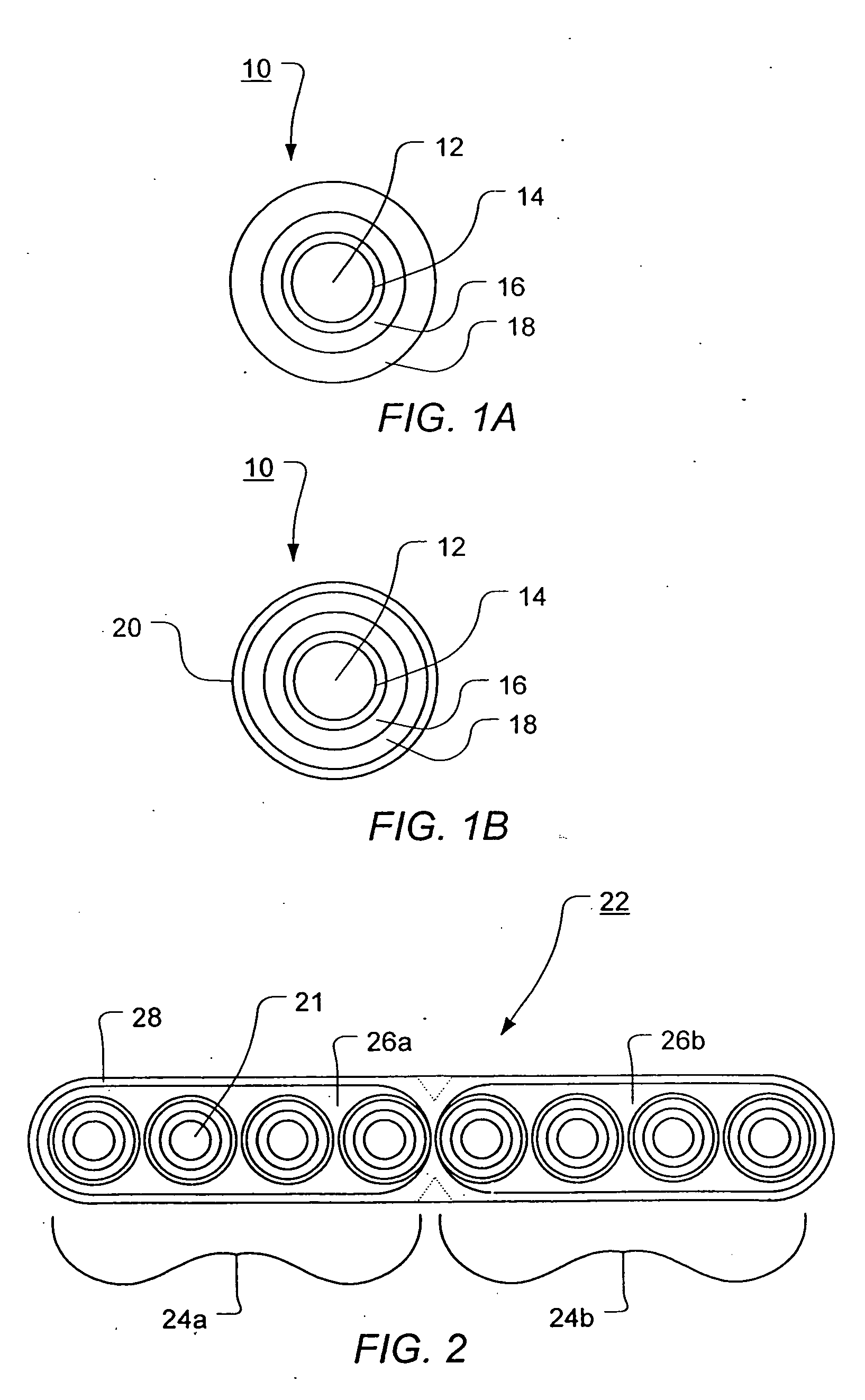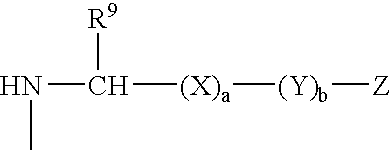Colored radiation curable coating compositions for identifying telecommunications elements and telecommunications elements coated thereby
a technology of color radiation and coating composition, applied in the direction of cladding optical fibre, glass optical fibre, instruments, etc., can solve the problems of pigmented color coatings having a relatively short shelf life, affecting the color performance of optical fibers, and affecting the quality of optical fibers
- Summary
- Abstract
- Description
- Claims
- Application Information
AI Technical Summary
Benefits of technology
Problems solved by technology
Method used
Image
Examples
example 1
Yellow Oligomer
[0097] 202.89 g of Milliken REACTINT™ dye yellow X15 was added dropwise to a mixture of 67.44 g isophorone diisocyanate (IPDI) and dibutyltin dilaurate that had been heated to 40° C. Care was taken that the exothermic reaction did not heat above 45° C. by controlling the addition rate. The total time taken for addition was two hours. After the last addition of IPDI, 200 g of 1,6 hexanediol diacrylate (HDODA) was added as a reactive diluent to lower viscosity along with 4.4 g of inhibitor 2,6-Di-tert-butyl-4-methylphenol. This mixture was maintained at 40° C. for two hours before addition of 35.24 g 2-hydroxyethyl acrylate (HEA) dropwise with the temperature maintained below 50° C. by controlling the rate of addition of HEA. One hour after addition, there was no detectible isocyanate peak at 2270 cm−1 as observed by FTIR. The resulting urethane acrylate oligomeric reaction product has a yellow color.
example 2
Blue Oligomer
[0098] 152.09 g of Milliken REACTINT™ dye blue X3LV was added dropwise to a mixture of 101.13 g isophorone diisocyanate (IPDI) and 2.98 g dibutyltin dilaurate that had been heated to 40° C. Care was taken that the exothermic reaction did not heat above 45° C. by controlling the addition rate. The total time taken for addition was two hours. After the last addition of IPDI, 200 g of 1,6 hexanediol diacrylate (HDODA) was added as a reactive diluent to lower viscosity along with 2.03 g of inhibitor 2,6-di-tert-butyl-4-methylphenol. This mixture was maintained at 40° C. for two hours before addition of 52.96 g 2-hydroxyethyl acrylate (HEA) dropwise with the temperature maintained below 50° C. by controlling the rate of addition of HEA. Two hours after addition, there was no detectible isocyanate peak at 2270 cm−‘as observed by FTIR. The resulting urethane acrylate oligomer reaction product has a blue color.
example 3
Black Oligomer
[0099] 226.67 g of Milliken REACTINT™ dye black X95AB was added dropwise to a mixture of 93.30 g isophorone diisocyanate (IPDI) and 2.74 g dibutyltin dilaurate that had been heated to 40° C. Care was taken that the exothermic reaction did not heat above 45° C. by controlling the addition rate. The total time taken for addition was about two hours. After the last addition of IPDI, 200 g of tetrahydrafuran (THF) solvent was added as a reactive diluent to lower viscosity along with 2.38 g of inhibitor 2,6-di-tert-butyl-4-methylphenol. This mixture was maintained at 40° C. for two hours before addition of 48.78 g 2-hydroxyethyl acrylate (HEA) dropwise with the temperature maintained below 50° C. by controlling the rate of addition of HEA. Two hours after addition, there was no detectible isocyanate peak at 2270 cm−1 as observed by FTIR. The THF solvent was then removed via rotovap vacuum technique at room temperature over a 10 h period until a weight equal to the original...
PUM
| Property | Measurement | Unit |
|---|---|---|
| weight percent | aaaaa | aaaaa |
| viscosity | aaaaa | aaaaa |
| temperature | aaaaa | aaaaa |
Abstract
Description
Claims
Application Information
 Login to View More
Login to View More - R&D
- Intellectual Property
- Life Sciences
- Materials
- Tech Scout
- Unparalleled Data Quality
- Higher Quality Content
- 60% Fewer Hallucinations
Browse by: Latest US Patents, China's latest patents, Technical Efficacy Thesaurus, Application Domain, Technology Topic, Popular Technical Reports.
© 2025 PatSnap. All rights reserved.Legal|Privacy policy|Modern Slavery Act Transparency Statement|Sitemap|About US| Contact US: help@patsnap.com



